The elf owl is the world’s smallest bird of prey, measuring just 12 centimeters (4.7 inches) in length with a wingspan of only 25 centimeters (9.8 inches). The black-thighed falconet is the lightest, weighing as little as 28 grams (1 ounce).
In this article, we highlight the smallest representatives from each major group of raptors, including owls, falcons, hawks, eagles, vultures, harriers, kites, and caracaras. Despite their tiny size, these hunters are well equipped to survive, using speed, agility, sharp senses, or opportunism to navigate a wide range of environments across the globe.
Elf owl (Micrathene whitneyi)
- Body length: As small as 12 cm (4.7 in).
- Weight: As little as 35 g (1.2 oz).
- Wingspan: About 25 cm (9.8 in).
- Where found: Arid woodlands and desert scrub of the southwestern U.S. and central Mexico.
- Conservation status: Least Concern.
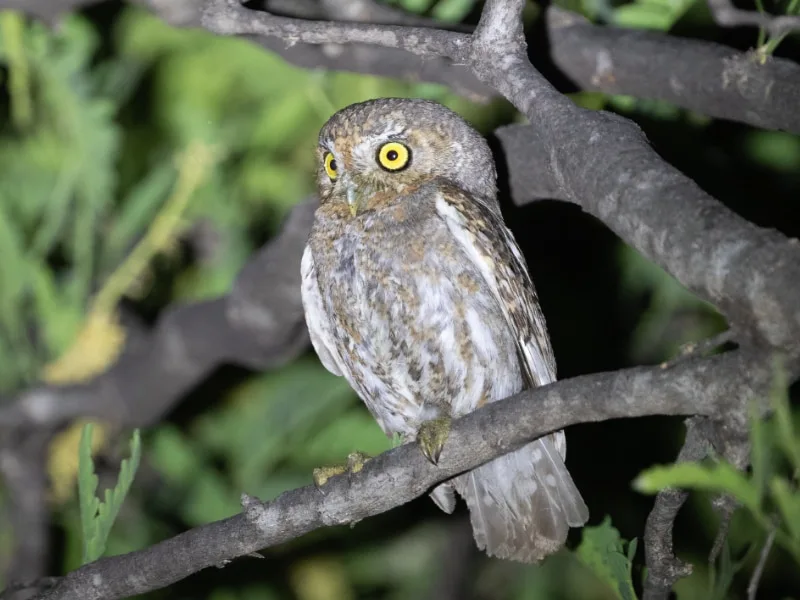
The elf owl is not only the world’s smallest owl but also the smallest bird of prey. Reaching just 12 centimeters (4.7 inches) in body length and with a wingspan of about 25 centimeters (9.8 inches), it is comparable in size to many songbirds. Despite its delicate frame and soft gray-brown plumage, the elf owl is a capable nocturnal predator. It uses its agility and silent flight to hunt insects in desert scrub and open woodland, weaving through saguaro cacti and mesquite stands with ease. With pale yellow eyes, subtle streaking, and narrow white “eyebrows,” it has a gentle, curious appearance.
The species occurs from central Mexico north into Arizona and Texas, where some populations migrate seasonally. It nests in old woodpecker cavities, often in cacti or trees, and becomes highly territorial during the breeding season. Males use persistent calls to defend nest sites and attract mates. One remarkable behavior in this tiny raptor is thanatosis, or feigning death when threatened. Although it remains widespread in parts of its range, the elf owl is vulnerable to ongoing habitat degradation and loss, especially in sensitive desert ecosystems.
Black-thighed falconet (Microhierax fringillarius)
- Body length: As small as 14 cm (5.5 in).
- Weight: As little as 28 g (1 oz).
- Wingspan: As short as 27 cm (10.6 in).
- Where found: Forests and open areas of Southeast Asia, including Thailand, Malaysia, Indonesia, and surrounding regions.
- Conservation status: Least Concern.
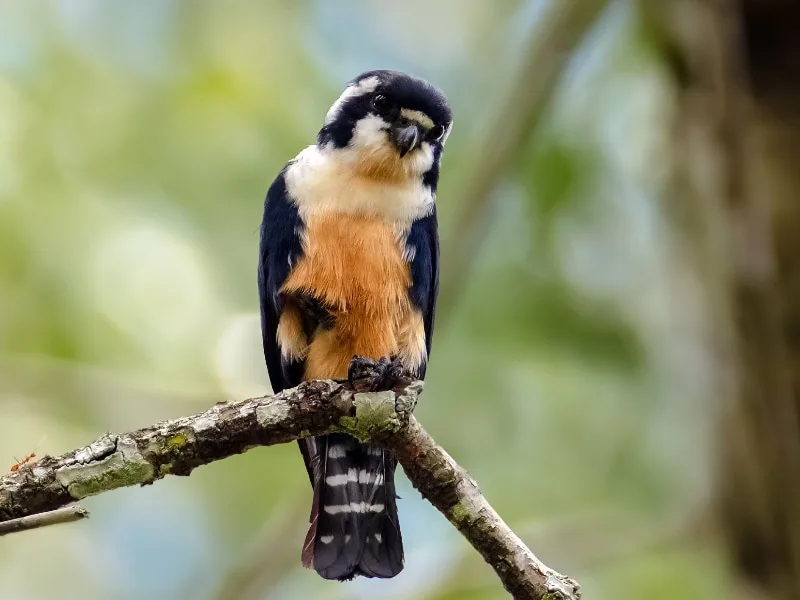
The black-thighed falconet is the smallest falcon in the world and one of the tiniest birds of prey overall. Measuring as little as 14 centimeters (5.5 inches) in length, with a wingspan of just 27 centimeters (10.6 inches), and weighing as little as 28 grams (1 ounce), this Southeast Asian raptor is scarcely larger than a sparrow. Despite its size, it is an agile and confident hunter, often seen perched prominently as it watches for insect prey. It hunts mainly during short, quick flights, feeding on moths, cicadas, termites, dragonflies, and sometimes small birds or lizards.
This falconet inhabits a range of wooded environments, from forest edges and riverine areas to cultivated landscapes and villages. It is generally social and frequently found in pairs or loose flocks of up to ten birds, sometimes even foraging together in small groups. Although it is locally common across much of its wide Southeast Asian range, including Thailand, Malaysia, Brunei, and Indonesia, the species is thought to be undergoing a slow decline due to habitat change. However, it remains widespread and is not considered globally threatened at present.
Pygmy falcon (Polihierax semitorquatus)
- Body length: As small as 18 cm (7.1 in).
- Weight: As little as 44 g (1.6 oz).
- Wingspan: As short as 34 cm (13.4 in).
- Where found: Arid savannas and dry woodlands of eastern and southern Africa.
- Conservation status: Least Concern.
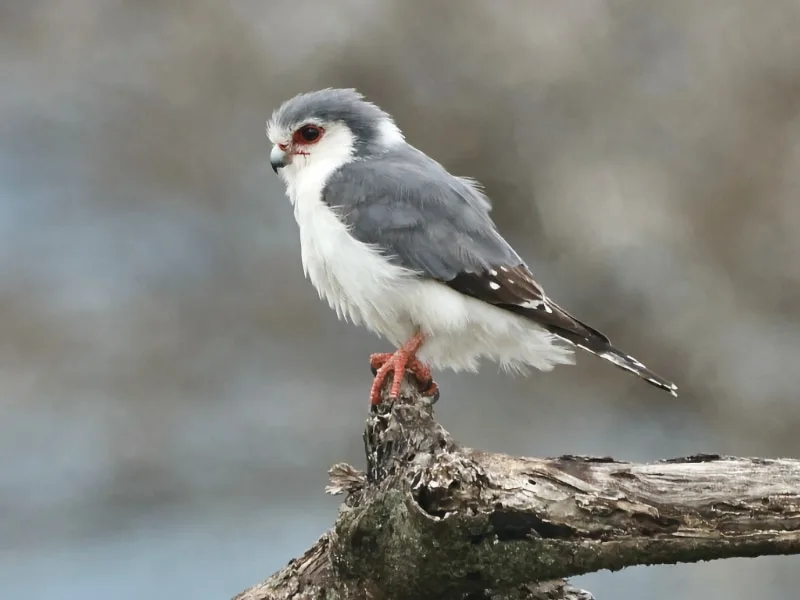
The pygmy falcon is the smallest bird of prey in Africa and among the tiniest raptors globally. Measuring only 18 centimeters (7.1 inches) in length and weighing as little as 44 grams (1.6 ounces), with a wingspan of just 34 centimeters (13.4 inches), it is a compact but highly capable predator. Found across dry savannas from South Sudan to South Africa, this tiny falcon typically hunts from elevated perches, swooping down to snatch insects, lizards, and small birds. Though minute in stature, it shows the sharp eyesight and sudden strikes characteristic of falcons.
The species is divided into two subspecies, with P. s. castanonotus occupying East Africa from South Sudan to Tanzania, and P. s. semitorquatus found across southwestern Africa from Angola to northern South Africa. It inhabits dry bush and thornveld, often nesting in communal weaver colonies, especially those of the sociable weaver. This unusual relationship provides the falcon shelter and thermal stability without having to construct its own nest. Despite its wide range, the pygmy falcon is rarely seen in large numbers, but populations are considered stable. Its small size, bold demeanor, and symbiotic nesting habits make it one of the most distinctive miniature raptors in the world.
Tiny hawk (Microspizias superciliosus)
- Body length: As small as 20 cm (7.9 in).
- Weight: As little as 75 g (2.6 oz).
- Wingspan: As short as 38 cm (15 in).
- Where found: Humid lowland and foothill forests of Central and South America.
- Conservation status: Least Concern.
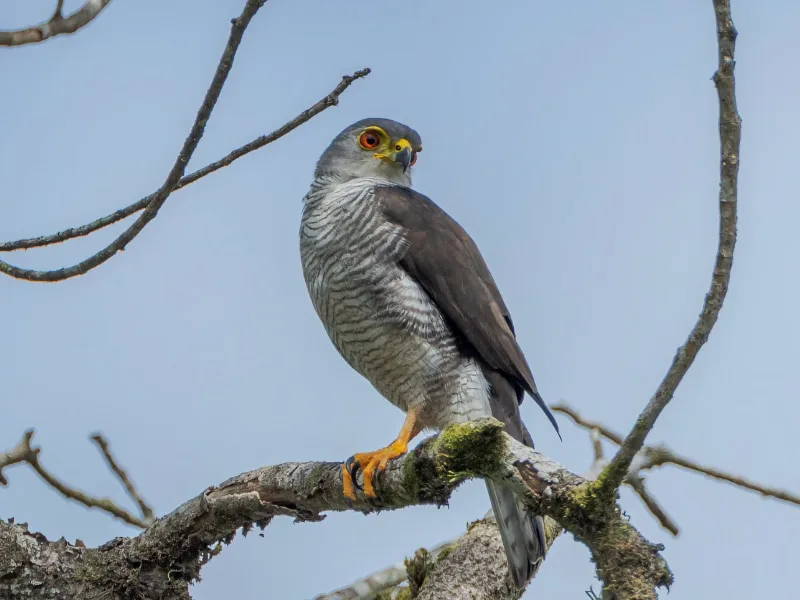
The tiny hawk is the smallest true hawk in the world, with adult males measuring just 20 centimeters (7.9 inches) in length and weighing as little as 75 grams (2.6 ounces) – about the size of a common starling. Females are notably larger, but even then, this species remains among the smallest accipitrid raptors globally. It has short, rounded wings and a long tail, suited for rapid, agile flight through dense forest. Unlike the typical glide-heavy flight of other hawks, the tiny hawk beats its wings in quick bursts, briefly folding them between flaps. Males and females are occasionally seen sunning together on open branches, but the species is mostly elusive and easily overlooked.
Its range stretches patchily from eastern Nicaragua to northern Argentina, with strongholds in the Amazon and Atlantic forests. The species typically inhabits humid lowland and foothill forests below 1000 meters, including secondary growth and forest edges. It hunts primarily from concealed perches in the midstory or understory, feeding mostly on small birds such as hummingbirds and passerines. Occasionally, it also hunts bats and small mammals. Despite being widespread, the species is rarely seen due to its secretive habits.
American kestrel (Falco sparverius)
- Body length: As small as 22 cm (8.7 in).
- Weight: As little as 80 g (2.8 oz).
- Wingspan: As short as 51 cm (20 in).
- Where found: Open and semi-open landscapes from Alaska and Canada to southern South America.
- Conservation status: Least Concern.
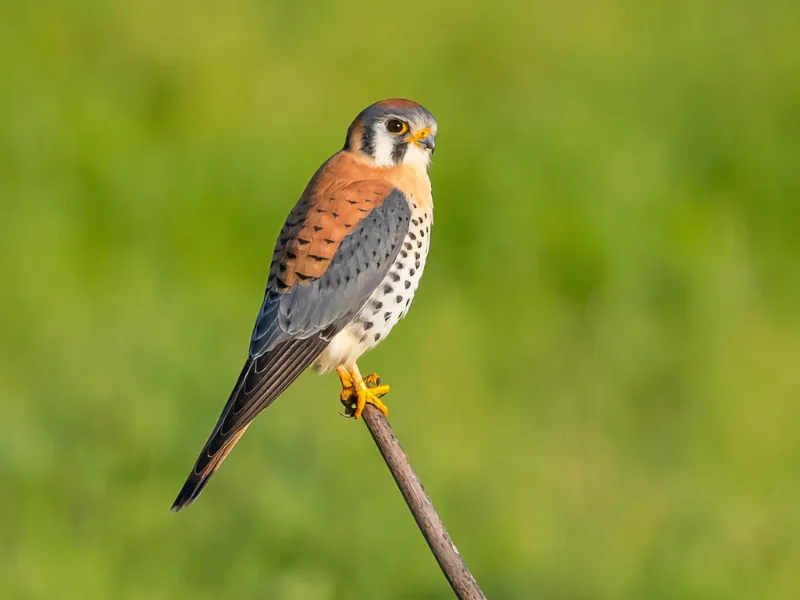
The American kestrel is the smallest falcon in the Americas and among the lightest birds of prey in the world. Measuring as little as 22 centimeters (8.7 inches) in body length and weighing only 80 grams (2.8 ounces), it is often mistaken for a songbird at a distance. Despite its small size, the kestrel is a capable hunter and highly adaptable, inhabiting open fields, deserts, farmlands, and even cityscapes across nearly the entire length of the Americas. It hunts primarily from exposed perches or while hovering, taking insects, small mammals, and birds. Its striking plumage, sexual dimorphism, and distinctive “klee-klee-klee” calls make it one of the most recognizable raptors in North America.
This species displays a mix of migratory and resident behavior, depending on the region. Northern populations move south in winter, sometimes as far as Central or northern South America, while others are year-round residents. It is a secondary cavity nester, often using tree hollows, abandoned woodpecker holes, or nest boxes. While still widespread, the American kestrel has declined significantly in parts of its range, particularly in the eastern U.S. Habitat loss, changes in prey availability, and collisions with vehicles are among the leading threats. Despite these challenges, conservation efforts such as nest box programs and public monitoring initiatives are helping to support populations in many areas.
Pearl kite (Gampsonyx swainsonii)
- Body length: As small as 20 cm (7.9 in).
- Weight: As little as 80 g (2.8 oz).
- Wingspan: As short as 45 cm (17.7 in).
- Where found: Open savannas and woodland edges from Central to South America.
- Conservation status: Least Concern.

The pearl kite is the smallest member of the kite group, measuring just 20 centimeters (7.9 inches) in length, with a wingspan as short as 45 centimeters (17.7 inches), and weighing as little as 80 grams (2.8 ounces). Despite its small frame, this species has broad, rounded wings and a relatively large head, giving it a compact and distinctive silhouette. Its name comes from its delicate, pale plumage markings that give it a “pearl-like” appearance.
Pearl kites are widely distributed across Central and South America, ranging from Nicaragua and Panama down to northern Argentina and Bolivia. They favor open savannas near deciduous woodland and are often seen perched conspicuously on exposed branches. From these perches, they swoop down to catch lizards, small birds, frogs, and large insects. In recent decades, the species has expanded its range northward, with breeding confirmed in Trinidad since the 1970s and more recent establishment in parts of Costa Rica. Unlike many forest hawks, the pearl kite tolerates habitat change and is even increasing across parts of its range.
Chimango caracara (Phalcoboenus chimango)
- Body length: As small as 32 cm (12.6 in).
- Weight: As little as 170 g (6 oz).
- Wingspan: As short as 80 cm (31.5 in).
- Where found: Open landscapes of southern South America, from central Chile and Argentina to Uruguay and southern Brazil.
- Conservation status: Least Concern.
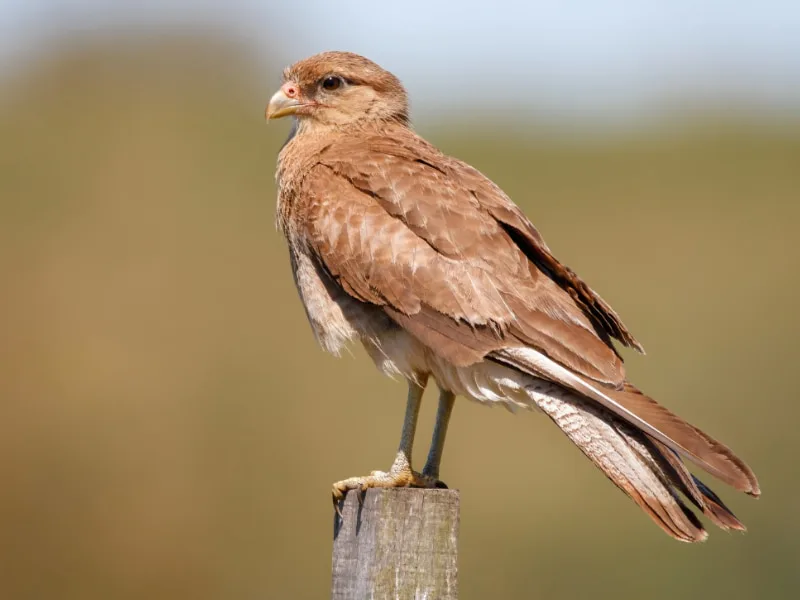
The chimango caracara is the smallest known caracara and one of the lightest birds of prey in the world. Adult individuals may measure as little as 32 centimeters (12.6 inches) in body length and weigh just 170 grams (6 ounces), with a wingspan of around 80 centimeters (31.5 inches). Found widely across southern South America, including Argentina, Chile, Uruguay, and Brazil, this adaptable raptor thrives in a variety of open habitats, from grasslands and marshes to farmlands and urban outskirts. It is especially common in the Argentinian Pampas and Patagonian steppe, where it frequently patrols roadsides, rubbish dumps, and agricultural areas.
Unlike falcons or hawks, the chimango caracara is an opportunistic omnivore. It feeds on insects, lizards, small mammals, bird eggs, and carrion, but is also known to consume fruit, fungi, and even animal dung. It often forages while flying low over fields and is quick to exploit human-altered landscapes, following plows, gathering near fish-processing sites, or attending grass fires to snatch fleeing prey. Highly social and curious, it is frequently seen in loose flocks and has even been observed stealing food from other birds. Its adaptability and generalist diet make it one of the most successful raptors in southern South America.
Pied harrier (Circus melanoleucos)
- Body length: As small as 41 cm (16.1 in).
- Weight: As little as 254 g (9 oz).
- Wingspan: Below 110 cm (43.3 in) in small males.
- Where found: Open habitats from southern Siberia to Southeast Asia.
- Conservation status: Least Concern.
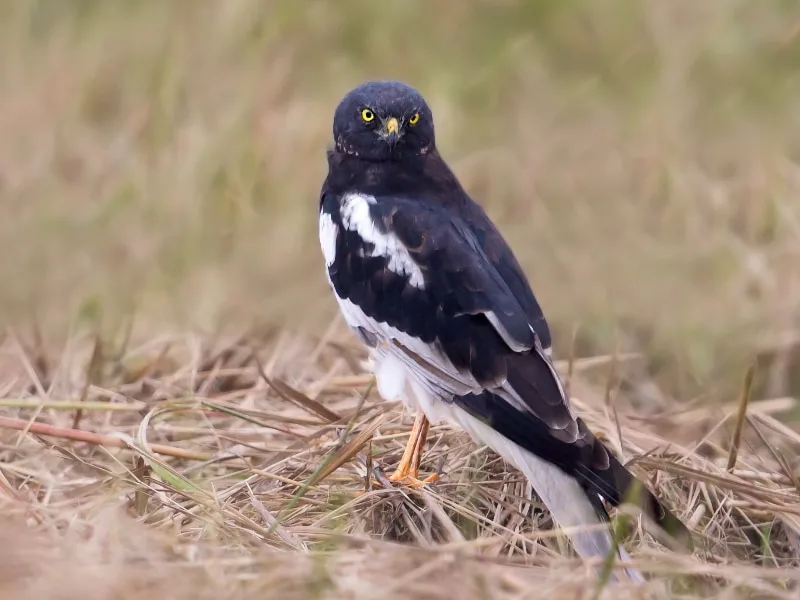
The pied harrier is the lightest known harrier species, with adult males reaching body lengths as small as 41 centimeters (16.1 inches), wingspans just under 110 centimeters (43.3 inches), and weighing as little as 254 grams (9 ounces). Slim-bodied and elegant in flight, this Asian raptor is distinguished by its striking black-and-white plumage in males. Unlike heavier harriers, it often forages low over open fields and marshes, relying on its light weight and maneuverability to hunt efficiently.
The species breeds in open steppes and boggy woodlands of southern Siberia, Mongolia, and northeast China, and winters across India, Southeast Asia, and the Philippines. It favors open country such as paddy fields, grasslands, and swampy plains, typically avoiding dense forests. Pied harriers are largely solitary but may form loose groups, especially during migration or at wintering grounds. They primarily prey on small mammals like voles and shrews, although birds, reptiles, amphibians, and large insects are also taken opportunistically. Despite local declines due to habitat change, the species remains widespread and is not currently considered globally threatened.
Great Nicobar serpent eagle (Spilornis klossi)
- Body length: As small as 38 cm (15 in).
- Weight: About 450 g (1 lb).
- Wingspan: As short as 85 cm (33.5 in).
- Where found: Dense tropical forests of Great Nicobar Island, India.
- Conservation status: Endangered.

The Great Nicobar serpent eagle stands out as the smallest known eagle in the world. With a body length as short as 38 centimeters (15 inches), a wingspan of just 85 centimeters (33.5 inches), and an adult weight around 450 grams (1 pound), it is notably compact for a member of the eagle group. This species is well adapted to the dense lowland rainforest of Great Nicobar Island, using its short rounded wings and broad tail to navigate tight spaces beneath the canopy. Its dark plumage, barred underside, and vivid yellow eyes make it instantly recognizable, though sightings remain rare due to its secretive behavior and highly restricted range.
Endemic to Great Nicobar in the Indian Ocean, this eagle is limited to intact forest habitats and is among the most range-restricted eagles globally. Estimates suggest a population of 150 to 370 mature individuals, though recent survey models indicate the real number may be closer to 200 adults. The species faces intense pressure from deforestation, road development, and potential displacement by more adaptable raptors such as the crested serpent eagle (Spilornis cheela). With such a limited distribution and mounting threats, its future remains uncertain without stronger conservation action.
Egyptian vulture (Neophron percnopterus)
- Body length: As small as 47 cm (18.5 in).
- Weight: As little as 1.6 kg (3.5 lbs).
- Wingspan: Around 150 cm (59 in).
- Where found: Open and arid regions across Europe, Africa, the Middle East, and the Indian subcontinent.
- Conservation status: Endangered.
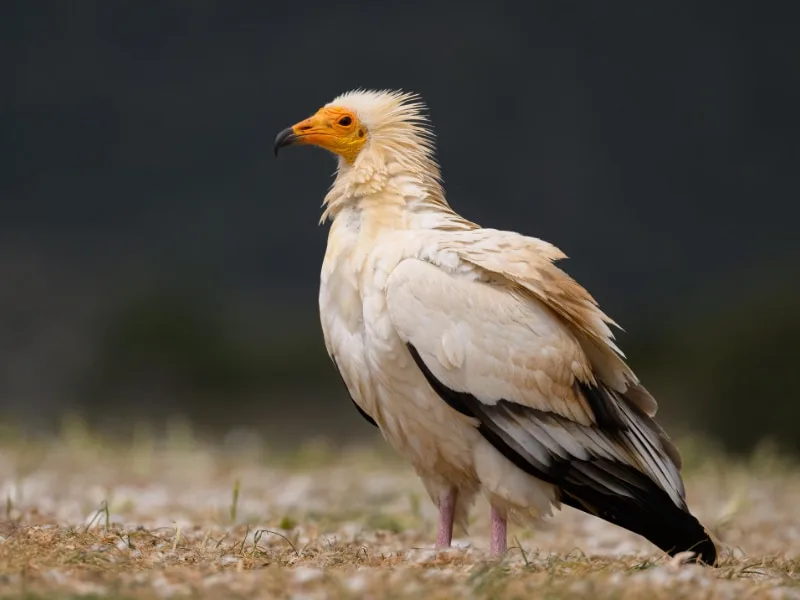
The Egyptian vulture is the smallest species in the vulture group, with males of the South Asian subspecies (N. p. ginginianus) measuring as little as 47 centimeters (18.5 inches) in length and weighing around 1.6 kilograms (3.5 pounds). Despite its slight build, it has a broad wingspan of about 150 centimeters (59 inches) and is capable of long-distance migration. Its appearance is striking: a slim white body with black flight feathers and a bare yellow face. It is known for its intelligence, tool use, and highly varied diet, which includes carrion, insects, eggs, and even waste. The species is typically solitary but may gather in loose groups at feeding sites such as rubbish dumps or carcasses, often scavenging in areas avoided by larger vultures.
The Egyptian vulture occupies a vast range spanning Europe, northern and sub-Saharan Africa, the Middle East, and South Asia. Northern breeders migrate to Africa in winter, while many tropical populations are resident. Nesting sites include rocky cliffs, large trees, buildings, or pylons. Although still locally common in parts of Africa and Europe, the species has experienced severe declines across much of its range, particularly in India, where poisoning from veterinary drugs such as diclofenac caused catastrophic losses. Additional threats include poisoning, electrocution, food scarcity, and habitat degradation. Conservation actions, including bans on harmful drugs and protection of nesting and foraging sites, are in progress, but long-term recovery remains uncertain.
Why these small raptors matter
Though small in stature, the world’s tiniest raptors are anything but minor players in their ecosystems. From agile insect hunters like the elf owl and pygmy falcon to opportunistic scavengers such as the chimango caracara, these birds demonstrate how precision, adaptability, and ecological awareness can be just as effective as brute strength. By occupying niches that larger birds of prey often cannot, they help maintain balance in both natural and human-shaped landscapes. Understanding and protecting these miniature predators is a reminder that in the world of raptors, size is only one part of the story.
Further reading
